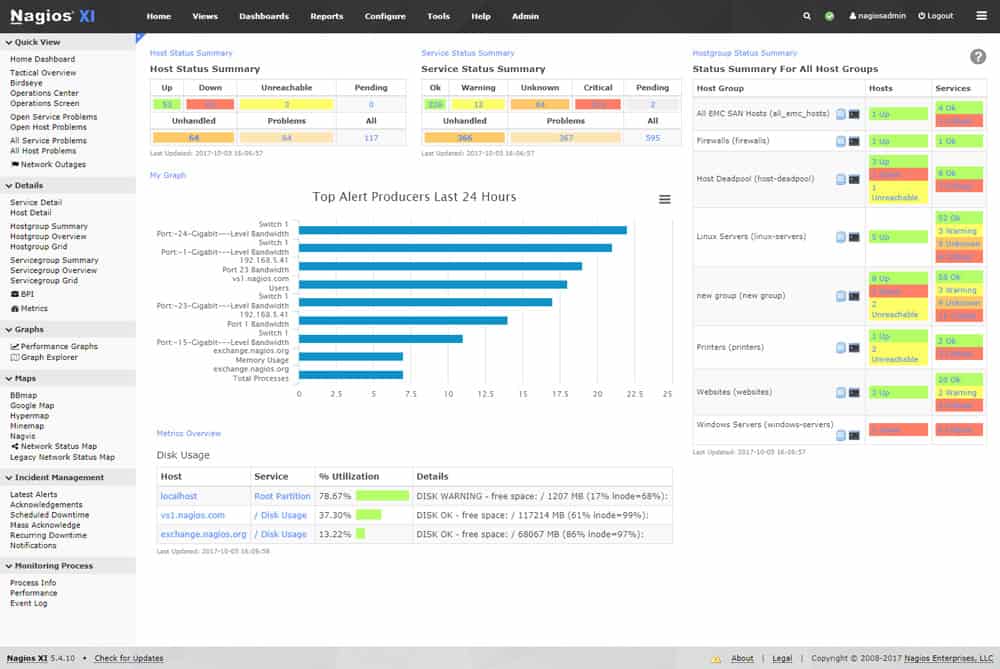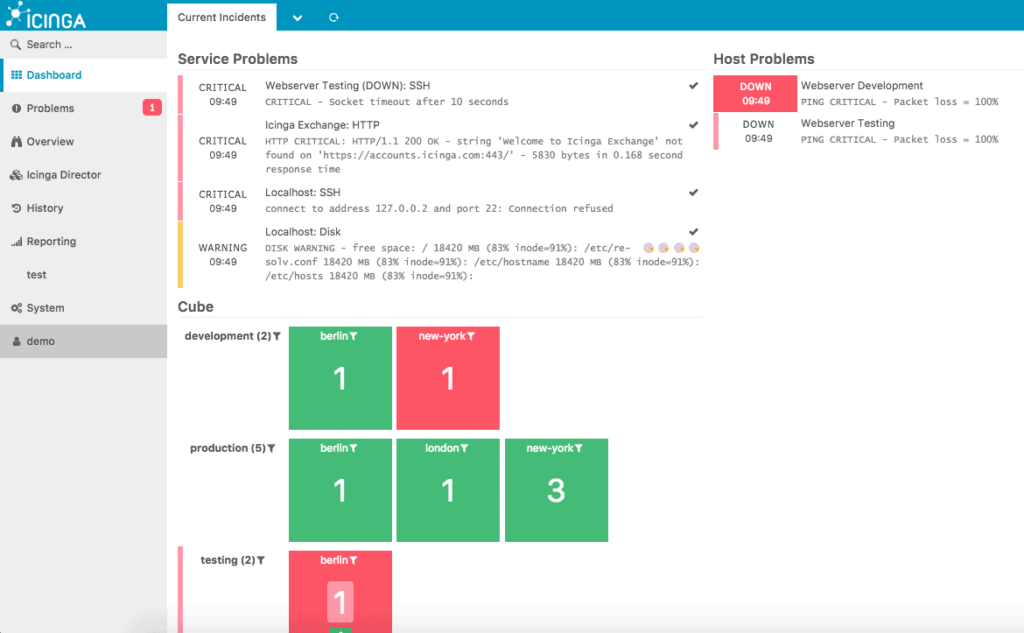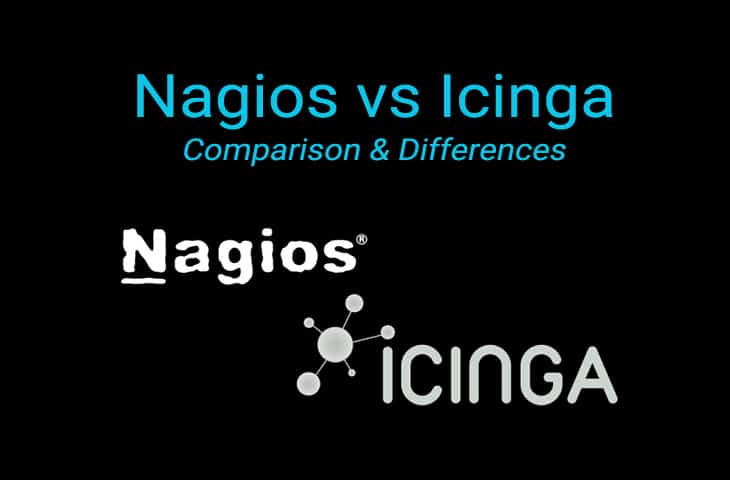Icinga is relatively new in the world of systems monitoring, even though it has been around for nearly 10 years already. It offers many great features and is its own standalone solution for systems and network monitoring.
Nagios on the other hand, is a well-established product with an enormous community that supports and creates add-ons for this fantastic product. Where Icinga stands out is that it is free and open source software, which means that it can be freely distributed with its source code, edited, and customized with the community in mind.
The only place that products like Icinga can start to cost you money is in the support and development categories. Nagios has a price tag of around $1,995 to start with, but that pricing includes some support if you need it.
This makes sense in large enterprise environments that seek to integrate the technologies with their own custom software, which is possible with Nagios. We will now take a closer look at each product, and see which one is best for your particular needs. Let’s get started
Nagios XI

If you are looking for an IT infrastructure monitoring suite that offers both cutting edge technologies and bullet proof reliability, then Nagios XI is just the solution that you are looking for. It offers both a monitoring and system alert feature that not only lets you know when a system goes offline, but what services are affected as well.
Nagios offers analytics insights that will keep you in the loop about what has happened on your network, and what the potential fixes could be by tracing out the faults on your network through the intuitive console.
Nagios Additional Features
https://www.nagios.com/resources/nagios-core/
https://www.nagios.com/products/nagios-xi/#features
Related Post: Nagios vs Cacti Comparison
Nagios XI has an easy to use web interface that makes the system great to navigate through, and also highly compatible with devices, from laptops and PCs to smartphones. If your device can run a modern browser, then you can use Nagios XI.
Pros:
- Open-source transparent tool
- Simple, yet informative interface
- Flexible alerting options support SMS and email
- Robust API backend makes it a great option for developers who want to integrate their own custom applications
- Very generous two-month trial period
Cons:
- Open-source version lacks quality support found in paid products
- Installation can be technical and complex
Nagios is able to monitor applications, services, OSes, network protocol monitoring, and loads more functionality, So you never have to guess why a system went offline.
Icinga

Icinga was initially released in May 2009 and has undergone many updates and upgrades, both functional and visual over the years. It is an open source project that has gained a massive fan base amongst monitoring fanatics, and it has functionality that you would expect to find only in an expensive enterprise solution.
Icinga uses a very similar series of plugins and add-ons to Nagios, and that is probably because Icinga began life as a pro community fork project of Nagios, although some would argue that Icinga has become a mature and stable enough product in its own right. Icinga operates through several different modules, namely Icinga Core, and the Icinga User interface. The user interface is available as a visual interface, and as a command interface.
Icinga Additional Features
https://www.icinga.com/products/icinga-2/
https://www.icinga.com/products/icinga-web-2/
https://icinga.com/docs/icinga-web/latest/doc/08-Modules/
https://www.icinga.com/products/cloud/
Icinga manages to retain compatibility with Nagios in some ways, and can even use the NRPE (Nagios Remote Plugin Executor) as a remote systems monitoring tool.
All in all, Icinga offers all of the essential functionality that one would expect in a scalable, feature-rich monitoring suite, and the community offers a lot of support material and information to help you get started.
Pros:
- Transparent open-source tool
- Can be configured via GUI or DSL, making it a good choice for admins who enjoy CLI tools
- Supports built-in visual reporting
- Modules allow for different functionality, keeping the base installation sleek and lightweight
- Can run on Linux as well as Windows operating systems
Cons:
- Reliant upon the open-source community for support and updates
- Designed for more technical users, other options have better out-of-box features
For those needing support, you can request a quote from this link here.
Icinga vs Nagios: What are the Main differences?
| Nagios | Icinga | |
| Network Scanning, Auto Discovery, Mapping & Visualization Maps | ✔ | ✔ |
| WMI ICMP SNMP | ✔ | ✔ |
| DB Functionality and Alerts | ✔ | ✔ |
| SLA Monitoring | ✔ | ✔ |
| Hardware Monitoring | ✔ | ✔ |
| Web Server Monitoring | ✔ | ✔ |
| Active Directory Alerts and Monitoring | ✔ | ✔ |
| Reports and Graphs of Historic Trends | ✔ | ✔ |
| Smart Device App: iOS, Android | ✔ | ✔ |
| Download Here | Download Here |
The great thing about both of these solutions is that there is definitely room for customization if you know what you are looking to do. There is a treasure trove of valuable plugins for each solution, and chances are good that you will find exactly what you are after, depending on what you need to do.
Icinga is an appealing product for small, medium or large scale businesses that value a reduced starting cost and customization options. Companies that save money on an initial investment with products like Icinga will find that they end up spending money in the integration of the system into their own applications, so the cost saving doesn’t necessarily mean that the product will cost you no money in the long run.
For small businesses, having a free monitoring suite such as Icinga is a good way to get up and running with no initial investment, something that cash strapped smaller businesses are always keen to take advantage of.
Nagios includes support as part of the package, which makes it a great product for businesses that need more than just a standalone product. This makes sense if your services, servers and network resources are all mission critical for your companies continued success.
Paying for a product that can give you support when you need it can be invaluable in times of crisis, something that both of these products can do. Download a fully functional version of Nagios XI that will run for 60 days so that you can test it out and see what features work best for you.
After you have finished demoing the product you can decide on which product to choose. Both of these products can give you the vision that you need on your corporate network, and because they come from the same original source, there are more similarities than there are differences.
It will all come down to which of these 2 pieces of software fits in better with your existing network and infrastructure. If we had to pick one though, it would probably be Nagios XI, just for the fact that it has such a great reputation in the industry, and offers so many great features out of the box, with excellent support.
There is a lot to like about both of these products, and if you would like to know more about each of them we have compile a list of features for each one. Nagios offers a support and maintenance plan to suite your budget, which can be found here.
The Nagios licensing quote page can be found here, while the Icinga support quotation page can be found here.
Happy monitoring and good luck!
Nagios vs Icinga FAQs
What types of tasks can be performed with systems management software?
Systems management software can perform a wide range of tasks, including patch management, software deployment, asset management, backup and recovery, performance monitoring, and security management, among others.
What are some popular systems management software solutions?
Some popular systems management software solutions include Microsoft System Center Configuration Manager (SCCM), IBM BigFix, Ivanti Unified Endpoint Manager, and VMware vRealize Suite.
What types of integrations and plugins are available for systems management software?
Systems management software can have a range of integrations and plugins that can extend its functionality, including plugins for monitoring specific applications and devices, as well as integrations with other tools and platforms.
How do systems management software solutions compare in terms of features and capabilities?
Systems management software solutions can vary widely in terms of features and capabilities, with some solutions offering a comprehensive suite of tools and others specializing in specific areas like patch management or asset management. It's important to evaluate each solution based on your specific needs and use cases.
What are some best practices for implementing and using systems management software?
Some best practices for implementing and using systems management software include defining clear objectives and success criteria, conducting a thorough needs assessment, establishing a governance model, and continuously monitoring and optimizing the solution.
Is icinga the same as Nagios?
Nagios Core and Icinga are two open source systems. “Open source” means that the code for the package is freely available and anyone can copy it and alter it for their own use. Icinga was created by a team that copied the Nagios code and produced their own version, naming it Icinga. A major attraction of the Nagios system is the very large library of plug-ins that are available for free at Nagios Exchange. These tools extend the Nagios system and some of them are provided by the creators of other monitoring systems to implement integrations with the Nagios platform. Icinga is fully compatible with Nagios and that means it can also take Nagios plug-ins.
What is hard and soft state in Nagios?
Nagios processes statistics that indicate the statuses of system components and interprets this information into a series so that it can be portrayed on a graph. Another use of this data is for comparison against pre-defined performance expectations, which are called thresholds. If a statistic passes a threshold level, Nagios generates an alert and that can be forwarded to the user as a notification. Any statistic could be erroneously reported, so Nagios verifies each figure. When a piece of data arrives, it is deemed to be in a “soft state.” Once the statistic has been verified, it is reclassified as being in a “hard state.” At this point, the data is counted as definitive when it gets to a hard state.
What is Icinga used for?
Icinga is used for IT infrastructure monitoring and is able to extract performance statistics to watch over networks, servers, and applications. The tool can monitor cloud services and Web assets and it is able to measure connection performance over networks and across the internet. The service also provides log management facilities and analytical features.




